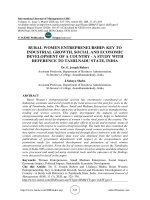Economic growth and economic development 581
Bạn đang xem bản rút gọn của tài liệu. Xem và tải ngay bản đầy đủ của tài liệu tại đây (153.83 KB, 1 trang )
Introduction to Modern Economic Growth
12.8. Exercises
Exercise 12.1. Derive equation (12.2).
Exercise 12.2. Prove Proposition 12.1. In particular:
(1) Show that even if pM = ψ, the unique (Nash) equilibrium involves q1 =
¡ ¢
D pM and qj = 0 for all j > 1. Why is this?
(2) Show that when pM > ψ, any price p1 > ψ or p1 < ψ cannot be profitmaximizing. Show that there cannot be an equilibrium in which p1 = ψ
and qj > 0 for some j > 1 [Hint: find a profitable deviation for firm 1].
(3) Prove that π
ˆ I1 > πI1 .
Exercise 12.3. Derive equation (12.5). Using these relationships, prove Proposition 12.2.
Exercise 12.4. Prove that if π
ˆ I1 > 0, then Sb1I > 0 (where these terms are defined
in Proposition 12.2).
Exercise 12.5. Consider the model in Section 12.3, and suppose that there is no
patent protection for the innovating firm. The firm can undertake two different types
of innovations at the same cost η. The first is a general technological improvement,
which can be copied by all firms. It reduces the marginal cost of production to
λ−1 ψ. The second is specific to the needs of the current firm and cannot be copied
by others. It reduces the marginal cost of production by λ0 < λ. Show that the firm
would never adopt the λ technology, but may adopt λ0 technology. Calculate the
difference in the social values generated by these two technologies.
Exercise 12.6. Prove Proposition 12.3. In particular, verify that the conclusion is
true even with limit pricing, i.e., ∆ˆ
π I1 < π I1 .
Exercise 12.7. Consider the model in Section 12.3 with an incumbent monopolist
and an entrant. Suppose that the cost of innovation for the incumbent is η, while
for the entrant it is χη, where χ ≥ 1.
(1) Explain why we may have χ > 1.
(2) Show that there exists χ
¯ > 1 such that if χ < χ
¯ , the entrant has greater
incentives to undertake innovation, and if χ > χ
¯ , the incumbent has greater
incentives to undertake innovation.
567









